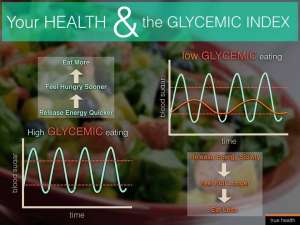 Do you know that not all carbohydrate foods are created equal, in fact, they behave quite differently in our bodies. The Glycemic Index (GI) – developed by Dr. Janette Brand-Miller at the University of Sydney- and popularized by researchers at Harvard, ranks carbohydrate foods according to their response on blood sugar levels.
Do you know that not all carbohydrate foods are created equal, in fact, they behave quite differently in our bodies. The Glycemic Index (GI) – developed by Dr. Janette Brand-Miller at the University of Sydney- and popularized by researchers at Harvard, ranks carbohydrate foods according to their response on blood sugar levels.
Look at the sample meals shown below. You’ll see examples of high-GI meals and low-GI makeovers. These simple meal makeovers are healthier alternatives that provide all the nutrition you need without causing that after meal “gush” of blood sugar.
BREAKFAST
High-GI to Low-GI makeover
- Corn flakes with skim milk change to Old-fashioned oatmeal with skim milk and peaches
- English muffin with jelly change to 100% stone-ground wholewheat toast or sprouted grain with sugar free jam
- Coffee (regular) change to Coffee (decaf)
LUNCH
High-GI to Low-GI makeover
- Turkey sandwich on white bread with lettuce and tomato change to Turkey sandwich on 100% stone-ground whole-wheat bread or sprouted grain with lettuce and tomato
- Watermelon change to Apple
- Ice tea (regular, sweetened) change to Ice tea (decaf)
DINNER
High-GI to Low-GI makeover
- Broiled chicken breast
- Mashed potatoes (instant) change to Converted rice
- Steamed green beans
- French bread change to Salad with vinaigrette dressing
WHY AFTER-MEAL BLOOD SUGAR LEVELS MATTER
Hemoglobin A1c is a measure of the average level of glucose in the blood over 3 months. Research has shown you can achieve normal A1c control but still be at risk of complications caused by abnormally high blood glucose levels. If you eat high-GI foods, your after-meal blood sugar will spike and then drop severely. Because A1c averages highs and lows, it will not reflect after-meal spikes that can damage tissue in your eyes, kidneys, and blood vessels. You may think you are in good control, but you’re not.
It is also important for people at risk of developing diabetes to avoid high-GI foods.
Here’s why: A spike in your blood sugar sends a signal to your pancreas to release insulin, which helps the sugar leave the bloodstream and enter the body’s cells, where it can be used later for fuel. High levels of insulin are associated with weight gain, high cholesterol levels, and high blood pressure. The high levels can also lead to insulin resistance, a component of the most common form of diabetes (type 2 diabetes). By using the Glycemic Index when you select your foods, you can help keep your insulin levels from rising too high, too quickly. When you eat low-GI foods, your blood sugar levels rise gradually. And, in response, your pancreas releases insulin gradually. By reducing after-meal blood sugar gushes, you also reduce after-meal insulin gushes and the health problems they can cause.
Join my 28 day, Be Healthy Program. You’ll detox your body and let the weight fall off as you learn how to keep your blood sugar stable throughout the day. You’ll learn how to eat and exercise for a slimmer waistline, better skin, more energy and a happier, Healthier You.
This is NOT a diet, this will become a lifestyle, a way of being that you’ll be able to do for your whole life, and want to because you feel so good!
To Your Health



